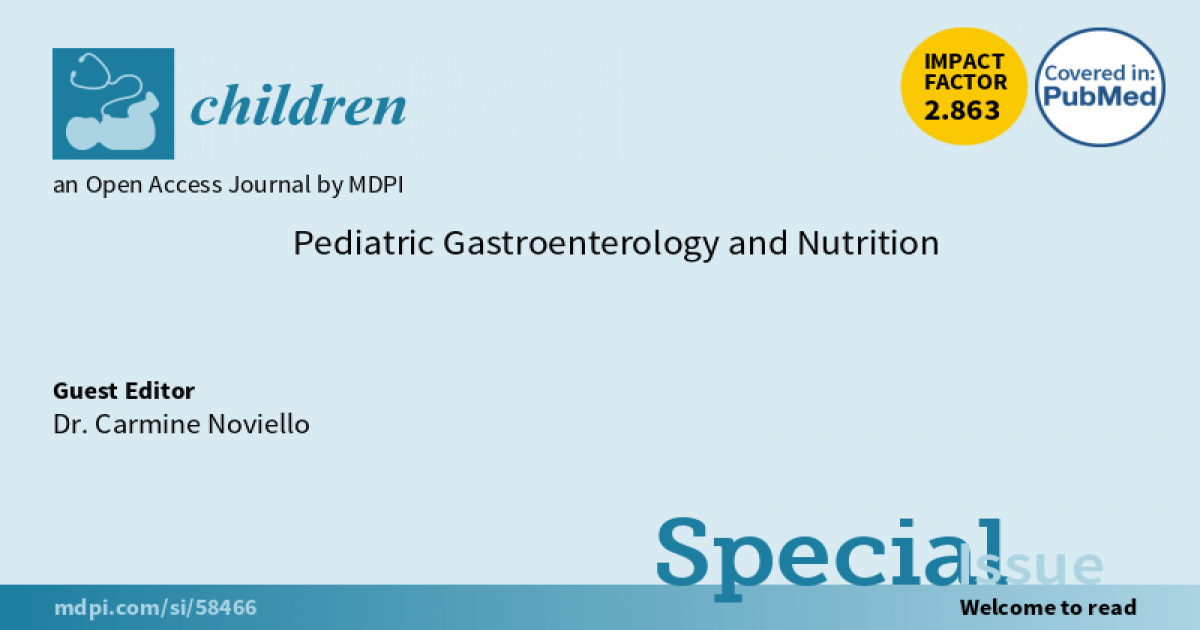Pediatric Gastroenterology and Nutrition
A special issue of Children (ISSN 2227-9067). This special issue belongs to the section "Pediatric Surgery".
Deadline for manuscript submissions: closed (1 February 2021) | Viewed by 25924

Special Issue Editor
Interests: gastroesophageal reflux; hirschsprung’s disease; esophageal atresia; constipation; gastrostomy; necrotizing enterocolitis
Special Issue Information
Dear Colleagues,
The problems of the gastrointestinal system are among those most studied in the pediatric field. Constipation alone has a prevalence that, according to some studies, reaches 30% of the pediatric population and is the reason a third of patients are visited by a pediatric gastroenterologist. These children need a precise diagnosis, considering that at this age, constipation can be a sign of malformative disease, and they also need appropriate care and continuous checks.
Another important problem that affects the pediatric population is nutrition in neurologically impaired and syndromics patients who often require surgical treatment: gastrostomy, fundoplication, jejunostomy, etc.
The field of interest is very big and involves pediatric gastroenterologists, pediatric surgeons, nutritionists and all those who are interested in diseases of the digestive system in pediatric age. The goal would be to make a collection of works that tackle all intestinal problems, from the newborn to the adolescent.
There are many ideas, starting from the study of the important problem of constipation to the nutritional approach in neurologically impaired patients , passing through the classic pediatric malformative diseases up to the big problem of necrotizing enterocolitis.
We count on the help of experts in this area to solve the issues related to the abovementioned topics through excellent contributions.
Dr. Carmine Noviello
Guest Editor
Manuscript Submission Information
Manuscripts should be submitted online at www.mdpi.com by registering and logging in to this website. Once you are registered, click here to go to the submission form. Manuscripts can be submitted until the deadline. All submissions that pass pre-check are peer-reviewed. Accepted papers will be published continuously in the journal (as soon as accepted) and will be listed together on the special issue website. Research articles, review articles as well as short communications are invited. For planned papers, a title and short abstract (about 250 words) can be sent to the Editorial Office for assessment.
Submitted manuscripts should not have been published previously, nor be under consideration for publication elsewhere (except conference proceedings papers). All manuscripts are thoroughly refereed through a single-blind peer-review process. A guide for authors and other relevant information for submission of manuscripts is available on the Instructions for Authors page. Children is an international peer-reviewed open access monthly journal published by MDPI.
Please visit the Instructions for Authors page before submitting a manuscript. The Article Processing Charge (APC) for publication in this open access journal is 2400 CHF (Swiss Francs). Submitted papers should be well formatted and use good English. Authors may use MDPI's English editing service prior to publication or during author revisions.
Keywords
- gastroesophageal reflux
- constipation
- gastroenterology
- necrotizing enterocolitis
- gastrostomy
- children
- pediatric surgery
Benefits of Publishing in a Special Issue
- Ease of navigation: Grouping papers by topic helps scholars navigate broad scope journals more efficiently.
- Greater discoverability: Special Issues support the reach and impact of scientific research. Articles in Special Issues are more discoverable and cited more frequently.
- Expansion of research network: Special Issues facilitate connections among authors, fostering scientific collaborations.
- External promotion: Articles in Special Issues are often promoted through the journal's social media, increasing their visibility.
- Reprint: MDPI Books provides the opportunity to republish successful Special Issues in book format, both online and in print.
Further information on MDPI's Special Issue policies can be found here.






